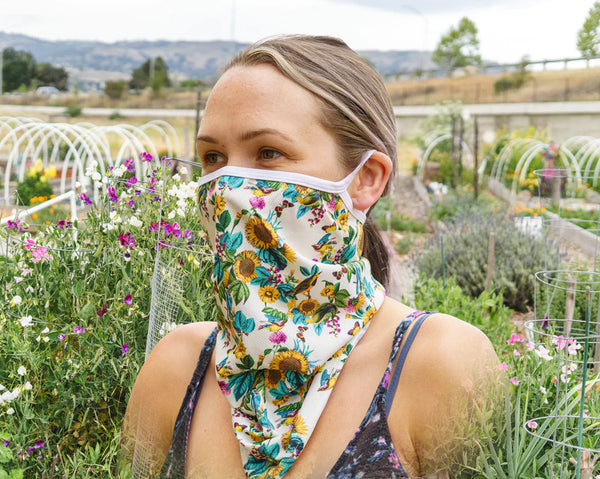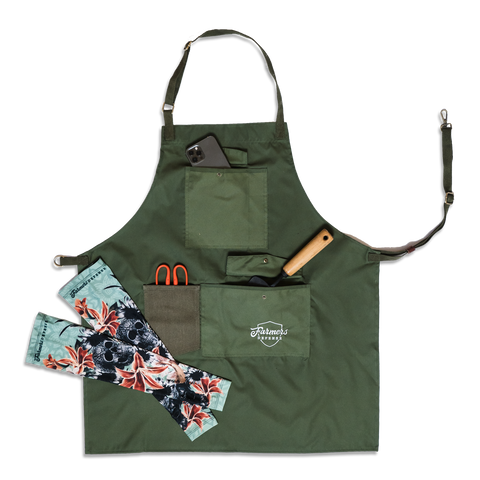Gardening Outfits: A Head-to-Toe Guide to Suiting Up While You Work
We know how it is when we go outside to get the mail and notice a little bit of harmless pruning and light watering that needs to be done. Maybe we pull a few weeds; why not? Next thing we know, we're knee-deep in soil harvesting those potatoes we forgot we planted in the back of the garden, still wearing our bathrobe and slippers.
Technically, there are few actual requirements for galavanting and gardening outdoors; as long as you have sunshine, soil, and some seeds, everything else will fall right into place (with some serious work and love and care, of course). But that doesn't mean what you wear isn't as crucial as the fertilizers and shears you select. Gardening is a delightful activity that connects us with nature, but it also exposes us to sun rays and potential injuries. To make the most of your gardening experience, the right attire is crucial. Just like you wouldn't hit the slopes without your ski gear, the garden is a place where dressing right can elevate your green thumb game. In this comprehensive guide, we'll explore the essential gardening attire from head to toe, combining comfort, functionality, and style for the perfect gardening outfit that will make your neighbors envious in the neighborhood's 'Best Veggie Garden' contest.

There's a lot of focus on function when it comes to what we wear, and this couldn't be any more true regarding the clothes we choose for gardening.
The ideal gardening outfit must meet two fundamental requirements: durability and comfort. But that doesn't mean it can't make a fashion statement too.
And who knows? The right outfit might give you that competitive edge when going toe-to-toe with the Joneses on who can rip it this year with the most luscious vegetable garden.
So we'll start from the top (literally the head) and make our way down to the toes, addressing comfort, safety, and function along the way.
Ok, now, from the top!
Sun Hats
Wide-brimmed straw hats are the most practical and popular amongst gardeners.
There's a ton of emphasis on protecting skin from sun exposure. So much so that the sun's damage to the eyes is often overlooked. Prolonged sun exposure can lead to vision damage and other complication over time.
Sun hats are a gardener's best friend, providing ample shade for your face, neck, and shoulders while shielding your eyes from harmful UV rays. Keep your cool and protect your skin with a wide-brimmed straw hat that adds a touch of style to your gardening ensemble.
There are times, mainly when doing work outside or digging in the garden, when we need to see clearly but still want protection from the sun. Sun hats are the perfect solution when sunglasses aren't the ideal solution.
Using a sun hat to keep direct sun rays off your face, neck, and shoulders in hot weather can help lower your body temperature.
Ideally, you'll want something that keeps the head cool and covered while shading your face, ears, neck, and shoulders, providing sufficient coverage.
 Eyewear
Eyewear
Eyewear is an important consideration when working in the garden.
Something that's anti-fog, with warm temperatures, it can be easy for glasses to fog, especially if you're using a gaiter or mask to protect your face.
UV Protection is a must when protecting your skin and your eyes. All sunglasses offer some level of UV protection (hence the name), but it's important to use a reputable brand that provides sufficient protection based on your needs.
Neck Gaiters
The neck gaiter can be one of the most versatile accessories in the garden.
It can serve as a face covering, headband, bandana, or neck warmer, protecting the face and neck from UV rays.
Not to mention all the potential capabilities it has in elevating swagger with different designs and patterns to match the rest of your 'fit.
Gaiters are versatile accessories that serve as face covers, headbands, bandanas, or neck warmers. These garden essentials keep you protected and stylish with a range of designs and patterns to suit your mood and outfit.

Gardening Pants
Pants are so essential but so often overlooked.
Sure, you can rock those old jeans stashed away in the closet, but choosing something lightweight and durable will ultimately be the best move.
And even though everyone seems to be flooding in their high waters these days, wearing pants long enough to cover your ankles will help protect you from skin irritants in the yard and garden.
Shirts
Gardening shirts really don't get the attention they deserve.
If we're wearing a shirt outside in the sun for long periods and get the old farmers' tan, we tend to think the skin that didn't burn was being protected. We're not wrong in that assumption, but to what degree is our skin being protected?
Just a cotton shirt doesn't really cut it when it comes to protecting our skin. All fabrics, in essence, have some level of UPF, but not all fabrics are created equal. Understanding the factors that go into UPF rating helps us differentiate between fabrics and ultimately choose the best option.
Opt for UPF protective sleeves for ultimate sun security. These powerhouse garments shield your skin from harmful UV rays, making sure you stay safe under the sun.
UPF protective sleeves are a game changer in the garden.
When working on a project outdoors or in the garden, long-sleeved shirts may effectively protect the skin from the sun, but they often leave us a little hot and sweaty. For this reason, arm sleeves are advantageous.
A denser, tighter fabric constructed from a polyester and nylon blend with moisture-wicking qualities, offering breathability works best. These materials stay dry and cool and typically protect sensitive and thin skin from scratches and sun exposure.
The best part about using arm sleeves with UPF protection is that there's no need to apply and reapply SPF sunscreen to the covered skin.
Farmers Defense Sleeves are the hassle-free solution to stay cool and sun-safe in the garden. Covering your arms from bicep to knuckles, these sleeves come in trendy colors and styles, adding a touch of fashion to your gardening look.

Footwear
Footwear can change drastically depending on the seasons.
Summertime is great for sandals and slides, but it can get a little dangerous in the garden with hazardous tools and irritating plant particles. Sometimes it's too hot to wear those ankle-high hikers or mud boots. Clogs can be a great happy medium, giving your toes protection while offering breathability.
Gardening Gloves
Your hands are literally in the thick of it all, so keeping them safe is essential.
Getting the right gloves can be confusing with many brands and styles to choose from, but a few features to look out for are breathable and sturdy knit fabric with flexible and durable coating on the palms and fingers. The coating will allow you to handle tools and plants more comfortably.
Choosing well-made gloves that can be machine washed is ideal. And having multiple pairs definitely doesn't hurt; when one gets muddy or soaked, you can swap them out while you wait for the others to wash and dry.
Protect your hands from cuts, scrapes, and blisters with durable and breathable gloves. Look for pairs with sturdy coatings on the palms and fingers like the PU gloves from Farmers Defense.

Gardening Aprons
Stay organized and garden smarter with Farmers Defense Gardening Aprons. These waterproof essentials are packed with pockets for shears, seeds, phone, and more, keeping everything you need within reach.
I met with our own expert gardener and creative mind behind the Farmers Defense TikTok, Tyla, and got her take on what makes for the best gardening outfit. "You never know exactly what you'll end up doing in the garden, so it's great to be able to carry your shears, some seeds, your phone, and a pen and notebook in your apron. That way you can continue gardening without constantly running in and out of the house."

We made our Gardening Aprons with just that in mind. Lots of pockets!
And no matter what season we're in, things tend to get wet, so our first line of defense against it should be a waterproof apron. That way, next time you're carrying that fresh harvest of tomatoes, they don't squish and soak through onto your outfit underneath.
Tyla went on to tell me more of her thought on the ideal gardening outfit:
"Gardeners need protection," she says, "from spike plants like cucurbits and the sun!" She knows this to be the number one issue in the garden, and that's what we've sought to address through the creation of our arm sleeves. Our arms are the most exposed part of us out there, and our mission is to keep them safe.
There are some crucial factors in choosing a proper gardening outfit: geographical considerations, the climate, the season, and what prickly and sticky giants you've got growing in the backyard. So suit up and be prepared for whatever life and the harvest season have to throw at you.





